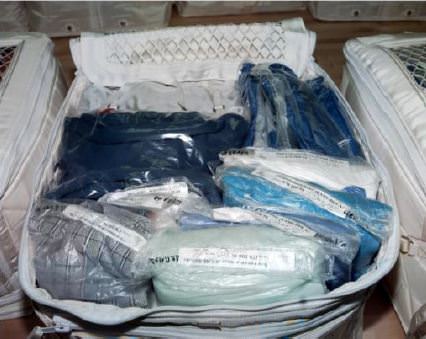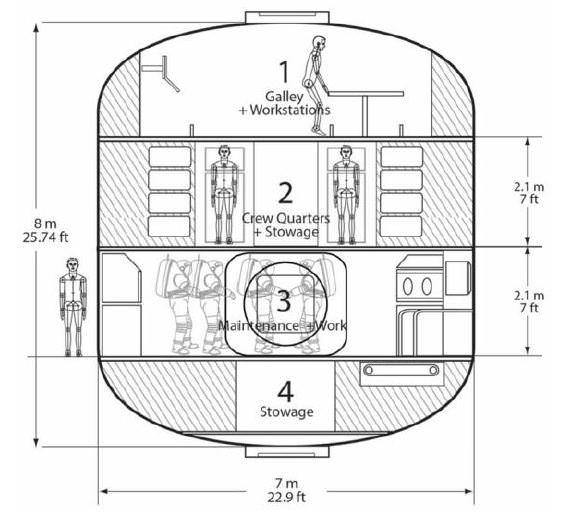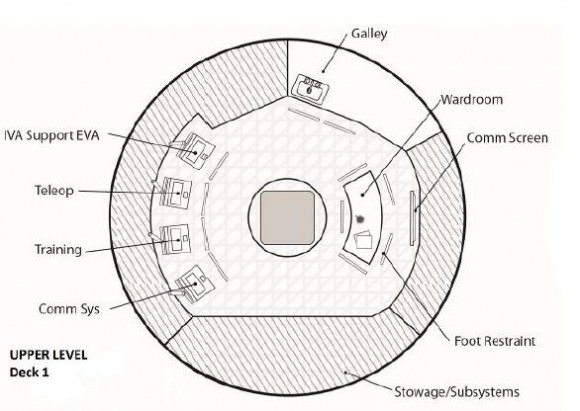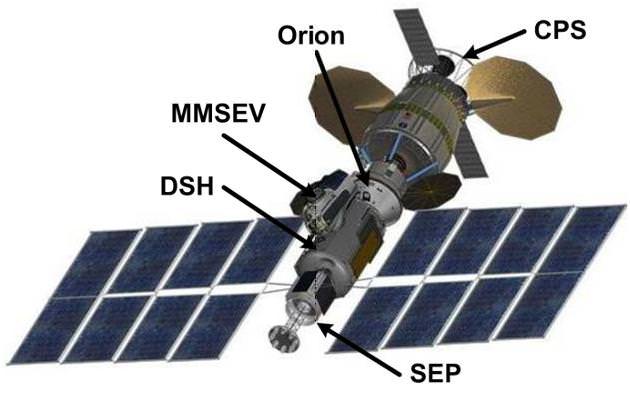Caption: The integrated vehicle stack for a deep space human mission concept. Credit: NASA
There are all sorts of details to take into consideration when traveling in deep space, such as where to go, what to do, and how to get back. Since starry-eyed dreamers often don’t take into account the practical realities of putting a human into such an environment, steely-eyed engineers are left to decide the gritty details of such a mission, such as how many pairs of socks are needed. Fortunately, NASA employs engineers who are both steely-eyed and starry-eyed, and their work has just produced an interesting report discussing the human side of deep-space exploration.
The paper, written by Michelle Rucker and Shelby Thompson of Johnson Space Center, focuses on the requirements of a ship that will take the first wave of deep-space human explorers to a near Earth asteroid (NEA), hopefully in the near future. The team stressed that they were only looking at very basic requirements and the paper only provides a basis to work from for more specialized teams that will design individual sub-systems.
To develop the basics, the team had to make some assumptions, and these assumptions are revealing for anyone interested in NASA’s future human exploration plans. The team assumed a 380 day round-trip mission to a NEA, crewed by 4 people, with just 30 days of the mission spent at the asteroid. They assumed the availability of a variety of mission-specific vehicles as well as the ability to perform extra-vehicular activities and dock with the Orion crew module, still under development at NASA. Nevertheless, such assumptions could lead to an exciting mission if they hold throughout the design process.

Caption: Two weeks worth of clothing in a crew transport bag. Credit: NASA
In addition to the assumptions, the team took advantage of knowledge gained from years of working on the International Space Station, and helped in considering details like how many packets of powdered drinks are needed for the duration of the trip as well as how much toothpaste a person uses daily in space. All of these numbers were crunched to derive overall dimensions for the craft.
Although, the sum of these volumes produced an over-sized spacecraft, the team evaluated activity frequency and duration to identify functions that could share a common volume without conflict, reducing the total volume by 24%. After adding 10% for growth, the resulting functional pressurized volume was calculated to be a minimum of 268 cu m (9,464 cu ft) distributed over the functions.
Those dimensions resulted in a 4 story structure totaling almost 280 cubic meters (10,000 cubic feet) of pressurized space that looks like it could have come right off the set of Prometheus.

Caption: Conceptual Deep Space Habitat layout. Credit: NASA/Michelle Rucker and Shelby Thompson.
The various subsystems can be broken into seven different categories. The largest is the equipment section, which takes up 22% of the spacecraft. This space would include things like the environmental control panel and navigation and communications equipment. However, the designers thought that the propulsion system, most likely a solar electric propulsion system, and all required control equipment would be part of an attachable module and would not make up part of the main living space of the habitat.
Mission Operations and Spacecraft Operations make up the next largest chunks of the habitable space, each clocking in at 20%. These areas are reserved for mission specific tasks that are not yet defined and general tasks that are necessary no matter what type of mission the habitat is launched on, such as basic maintenance and repair.
Much consideration was given to the psychological and privacy needs of the inhabitants of the ship and as such about 30% of the total habitable space is devoted to the care of the people on board, with 18% going to “individual” care and 12% going to “group” care.

Caption: Group living and operations area of a conceptual deep space habitat module. Credit: NASA/Michelle Rucker and Shelby Thompson.
Individual care includes basics such as beds, full body cleansing and toilets. Group care is more for multi-person activities, such as a dining hall, food prep and meeting areas. The last 2% of the area on board was allotted to “contingency” planning. It fits its namesake well, as the design team hopes never to have to use the space whose primary purpose is to deal with cabin depressurization, crew fatality or other unforeseeable disaster. There is also a shielded area in the interior of the habitat for refuge for the crew during a solar radiation event.
With the basics laid out, it is now up to the specialist teams to develop the next set of requirements for the sub-systems. The final design will only be completed after a long and iterative process of calculation and re-calculation, design and re-design. Assuming the teams persevere, and the space agency receives adequate funding for developing a deep space mission to an asteroid, NASA’s detail-oriented engineers will have developed a very flexible habitat module to use on the next step of human space exploration that dreamers everywhere can get excited about.
Source: NASA Technical Report: Developing a Habitat for Long Duration, Deep Space Mission
Andy Tomaswick, an electrical engineer who follows space science and technology.


http://ntrs.nasa.gov/search.jsp?R=20120008183
“403 Forbidden
You don’t have permission to access /search.jsp
on this server”
sniff, sniff 🙁
I acutally have trouble accessing it at first as well, though I’m from the US. I don’t think it was the same error, but opening it from a different browswer might help. Internet Explorer was the only one that worked for me.
Shame, it works for me. But here’s the direct link to the report pdf, hope that works:
http://ntrs.nasa.gov/archive/nasa/casi.ntrs.nasa.gov/20120008183_2012008354.pdf
Ah well – maybe its region-locked (I’m in the UK) – still can’t access it; I’ll try tunneling / public VPN when I’m back home…. Thanks anyway Aerandir90
I’m on a US Government computer and I get the same error. Tried going direct to the NTRS site and it also told me I didn’t have permission. grrr…
I am on my home computer using “Opera” and the link worked for me.
Unfortunately SLS/Orion development cost $3 billion per year and do not leave much funding to develop these great ideas. But I nite that no yse is made of Orion internal space so another return vehicle could be used. So if Orion/SLS were scrapped the money saved could be used to develope the deep space habitat. Dragon could be used as the return vehicle and the individual components could be launched on Falcon Heavy and assembled in space.
Sweet, though I wished you NASA folk would spend some money on artificial-G systems. We all know that’s how it needs to be eventually, especially for long duration missions, so why not start working on it now.
The spacecraft wouldn’t have to be in a continuous spin either. Intermittent ‘conditioning’ may provide a good amount of physiological benefit to the crew. The agency should at least be doing some preliminary hardware testing and research in orbit.
On a different note, I also don’t think NASA astronauts have stayed in space for that long at a time (correct me if I’m wrong). Maybe one of the next ISS crews (or the American part of it at least) should stay in space for 380 days or more just to test physiological effects in a safer and more controlled environment. Of course there is a lot of time for this since the first manned Orion mission will probably only take place in the early-mid 20s. Maybe a precursor mission would be to just orbit Earth for that long, maybe even in HEO so that the crew would get experience in a more realistic environment with regards to radiation.
Yes! I’m dying to see an artificial-G test in orbit, even if it’s just a simple tether swinging a module around a counter-weight.
Honestly. Two boxes on a long truss, swung around a central point of gravity. Use lab animals inside of it with video cameras to see if they go about their business okay.
They already did that in 1966 on Gemini 11
That produced only very feeble amounts of artificial gravity
We don’t know that.
In fact, seeing the recent medical results here, I doubt we will see artificial-g in general.
I’m going to cheat on refs this time, but I clearly remember reading a few weeks back that it looks that free fall isn’t harmful as such. Or rather, the strength (and so, I assume, bone density) decrease will stabilize on a measure that equals how much exercise you put in.
Then, overshadowed by the Higgs results, they have found that nematodes in orbit live longer. [Yes, we will see a rush of billionaires to out-sized Bigelow retirement homes. Extra years, internet access and space sex – who’s gonna say no!?] This means free fall is likely inherently beneficial for animals, even if, or perhaps because, the immune system is down-regulated.
Artificial-g may be useful in the future, as you will probably need it for healthy development after births in space. So any artificial long term habitats will likely have crib sections with it. I doubt they want to loose the extra years, if it transfers onto higher animals.
The longest cumulative times in orbit are Krikalov’s 803 and Avdeyev’s 748 days.
While I agree it might not be necessary in the long run, I still think research into it will be useful, especially if large groups of people start to travel in deep space together. Anyone who read Ender’s Game can explain how bad of an idea it is to have a bunch of semi-trained people trying to float around each other.
Found your nematode article.
(Incidentally, when I searched ‘nematodes live longer in space’, your comment was the 2nd search result)
From the article:
“Mammals, including people, in the microgravity of space are under physiological stress, says D. Marshall Porterfield, director of NASA’s Space Life and Physical Sciences Research and Applications Division in Greenbelt, Md. In low gravity, muscles atrophy and aging accelerates.”
Isn’t it now an irrefutable fact that prolonged weightlessness will cause a variety of physiological problems for humans at least? In my opinion, this research area should then deserve significant priority before we do any long-term deep-space missions. (This along with radiation protection). Methods to mitigate these physiological effects should be investigated whole-heartedly. Spinning to create artificial Gs isn’t the only viable solution. In our day and age of genetics knowledge, it may be possible to bioengineer our bones to withstand such effects. But there are also other issues like inner ear balance problems.
Lastly, the longest times in orbit (non-cumulative) make for a more relevant statistic because exposure to gravity when you return to Earth will begin to offset the symptoms of living in weightlessness.
Most of the top 10 records belong to the Russians. NASA needs more experience in this arena.
Actually, the MMSEV they mention in the paper has a relatively simple artificial gravity system as part of it’s design. See http://en.wikipedia.org/wiki/Nautilus-X#ISS_centrifuge_demonstration for more details.
A Multi Mission Space Exploration Vehicle (MMSEV) is nothing like that. It is a transport vehicle for NEO missions or later wheeled use. Think Space:1999.
Got it; sorry, I was too trusting of Wikipedia…
For those having trouble accessing the website with the abstract, the actual article is at
http://ntrs.nasa.gov/archive/nasa/casi.ntrs.nasa.gov/20120008183_2012008354.pdf
I must confess that I suspect a program of this sort would come at the expense of actual space science and space based astronomy. The big question remains with this, why should we devote resources to this when it is not clear there is any purpose for it, or that human beings can really live in space environments over indefinate time periods.
LC
For the same reason that married men have a garden shed – to get away from the bloody house when the mother-in-law comes to visit!
While we disagree on views of manned spaceflight, I agree with you on the lack of direction and general sloppiness of this whole program. The President told them to go to an asteroid, so they are! Wonderful.
But I’d imagine that a manned mission to an asteroid would have a great amount of science value. A mission where astronauts can probe and study at will with a much quicker turn-around period for subsequent investigations.
Of course, science isn’t the only reason to have a deep-space mission.
By the way, thanks Icrowell, for posting the alternative link to the abstract. Unfortunately, like a lot of others in the comments section, I can’t get through on that link either. I get the aforementioned “403 Forbidden” error.
Is there any chance someone who has already downloaded the file post it elsewhere and give us a link to it? I, and the others having trouble downloading it, would be very grateful! Thanks!
FYI, your comment (with links) was caught in the Disqus spam filter for some reason. I have now approved it.
Great, thanks. I repeatedly tried to post it as it didn’t work the first time. Guess it got picked off as spam.
Looking at the proposed Deep Space Habitat,makes me wonder if it could be built by The Marshall Spaceflight Center with cooperation from Bigalow Industries.Its dimensoins match those of the habitat he’s currently doing research on.This cooperation would be cheaper than the government doing it on its own.Also the design on the module appears to be similar to Skylab and that’s why Marshall should be responsible for its development,along with Bigalow Industries.The design appears to be feasible but the cost is another question but by working together with Private industry the cost could be reduced to manageable, affordable level.
I am from India and I was able to get access to the site
http://ntrs.nasa.gov/search.jsp?R=20120008183
I’m a little concerned about the various solar panels possibly blocking each other?
Having for years contemplated this incredible technology, of mining asteroids, it now is becoming reality, thanks to the future that God provides, in limitless supply no less. The logistics of micro gravity environments, wherein manufacture and conversion of resource can occur, can be attained by a craft that would be defined as a “space sled”, a vast flat surface that engages ” Photonically ” by both optical and invisible wave length power sources. This is converted to create “propulsion ionization.energy” that then increases acceleration into and within the desired orbit, at a specified forward acceleration, balanced to provide an ideal micro gravity for human function. So, the sled, is basically several hundred acres of flat surface facing the sun. On the side facing away there are modular living and manufacturing “levels”, created by extrusion and injection molding modules. The pre programmed modules would be forwarded by relocating the existing space station and providing stepping stone units from that location.
One reason,perhaps the most viable, is that “space sled” can be constructed by extrusion in the primary sequence, and then expanded without having to deploy a complicated folded configuration. The entire array facing the sun would be cooled, if necessary, by slightly “tipping” the entire sled. As the sled increases in size there is a corresponding increase in available power, The light weight metal alloy resins for molding and extruding would be sent up from earth in “canisters”. This is where MAG-LEV technologies must be employed. It becomes every nation’s responsibility to abandon the fuel propellant technology that is not dependent on consuming the earth’s atmosphere, as quickly as possible. This is where the ecologically sane strategies must be a pre requisite.
The typo at the conclusion below is obvious. We need to stop destroying the atmosphere if we are going to embark on the deeper space projects, thus we must employ mag lev technology. We are seeing the initiation of a technology that can be deployed into earth or solar orbit. In solar configuration, a sled could be located at an ideal distance for six shorter “years” of orbital transit. Eventually, and by the same sled technology, the gravity of the sun can and will be used to attain the slingshot warp speeds required to journey further out into the solar system. For now, and with that in mind, the mining of asteroids seems quite attainable in the near future.
In my lengthy comments yesterday I proposed ideas for space travel by “Solar Sled”. The sled configuration is a large flat field of solar panels that is facing the sun. The entire sled revolves in a sustained orbit at a speed which provides a micro gravity environment for the living and manufacturing environment located beneath the panels. Large cargo bays would also be located “beneath” the array for warehousing raw materials that are robot extracted and “refined”on the actual asteroid. Separating wheat from chafe and leaving mining residue at the primary source, and delivering the raw ore to the sled where refractory processes can occur, using optically concentrated solar energy to provide the required high temperature for melt.